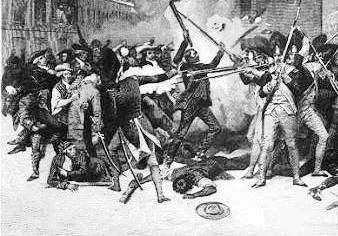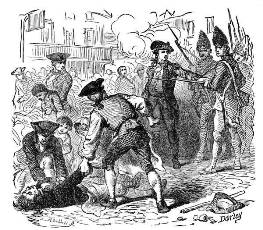
Engraving
Illustration: Print issued by Paul Revere
In 1770 tensions were high between Bostonians and Redcoats sent to Boston in the wake of the Stamp Act riots. Occasionally things would erupt into fist fights and angry confrontations. On March 5, Private White, on guard at the Custom’s house in King’s Street (now State Street) left his sentry box and struck young Edward Garrick in the face with the butt of his musket for insulting his commanding officer. White soon found himself surrounded by an angry mob that hurled taunts and snowballs at him.
Captain Preston of the 29th Regiment arrived with eight Redcoats to reinforce White. The troops forced their way through the increasingly hostile crowd, now swollen to several hundred people. Amidst a hail of snowballs and rocks, a club thrown from the crowd struck Private Montgomery in the face. Witnesses said Montgomery then fired the first shot. The crowd continued to press on the soldiers and more shots were fired. When the smoke cleared, five men lay dead or dying.
http: //www.thefreedomtrail.org/visitor/boston-massacre.html
| Riot and self
defense, or massacre? The extract on the right, suggests that the above illustration of this incident in Boston, is unreliable and inaccurate. a)
List in your workbook, the
criticisms that the writer makes about this above engraving illustration,
that was produced just after the 'massacre'. c)
Following your own research on
this incident, do you think that this above engraving could be
described as an early example of political propaganda? d) What motive would the American 'patriots' have for producing this engraving, and circulating it throughout the colonies? |
|
|
|
|

